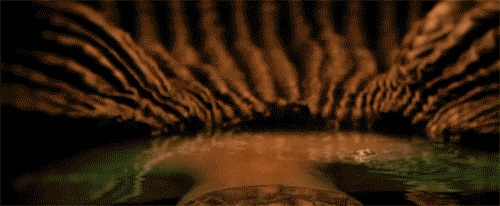The Cell (2000)
For anyone curious about diving into horror, “The Cell” is the ultimate plunge — a journey inside the mind of a killer.
In most horror films, a killer or monster intrudes upon our world and our dreams. “The Cell” is cool and refreshing in that it’s a “Nightmare on Elm Street”-type film that shows the opposite — characters willingly entering a monster’s world.
Jennifer Lopez stars as a psychologist who enters the dreams of a comatose killer (Vincent D’Onofrio) in the hopes of finding his latest victim. Vince Vaughn is an FBI agent equally eager to employ this dream-traveling technology and plumb the darkest depths.
Once inside the killer’s dreamworld, the film turns into a funhouse ride. It barrels along on the fun, twisted concept of a murderer imagining himself as a larger-than-life, Freddy Krueger-type figure. All the while, it offers indelible imagery, the kind you’re afraid of seeing later when you close your eyes. (This one below often prevented me from swimming in a pool for fear of seeing Vincent D’Onofrio’s scaly, reptilian head emerge from it.)

It would be easy to dismiss “The Cell” as shallow work, a triumph of style over substance. But what sets the film apart from other horror spectacles is the level of personal history director Tarsem Singh brings to it. For instance, in the scene wherein Lopez’s character finds Stargher cleaning his first victim, the setting bears a striking resemblance to that of Singh’s music video for R.E.M.’s “Losing My Religion.”
Stargher’s mindscape has the kind of rich, tangible texture lacking in many of today’s CGI-fests. In this scene, you can feel the velvety weight of Stargher’s cape as it unfurls.
Oddly enough, what’s more startling than Stargher’s fantasies are the memories of his real life. The exploration of Stargher’s childhood is a disturbing reflection of this country’s obsession with finding the humanity in monsters. At the end of the day, there is no solid justification for cold-blooded murder yet we keep searching for reasons anyway. Look at how news stories of shootings focus on the killers more than their victims. “The Cell” ultimately aims to haunt us with the notion that when we kill a monster, we destroy the human behind it as well. Provocative stuff. And fortunately, these are themes screenwriter Mark Protosevich tackles without ever preaching.
Lopez’s character seems to symbolize our arrogance in making humans out of monsters. She believes that if she can bring Stargher into her mind, she can “save him.”
The major flaw of “The Cell” is the fact that its setting is more engaging than its characters. It’s better to think of them as tour guides in an arresting funhouse rather than full-fledged characters. The fact that their homeworld doesn’t seem as tangible or vivid as their dreamscapes is deeply disturbing and ironic.
“The Silence of the Lambs” by way of “The Matrix,” “The Cell” is familiar yet also fresh. With its strange visuals and even more unusual cast, it is bound to turn people away. But for those brave enough to enter its world, you’re in for quite a ride.
